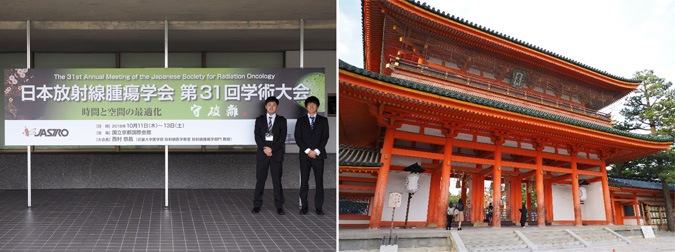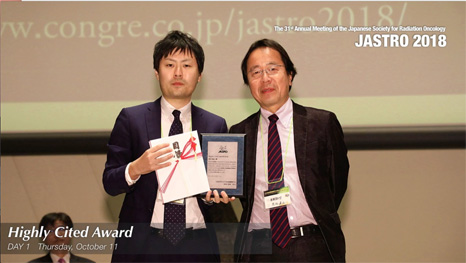2018.10.11-10.13: The 31st Annual Meeting of the Japanese Society for Radiation Oncology (JASTRO)
The 31st Annual Meeting of the Japanese Society for Radiation Oncology (JASTRO) held in Kyoto International Conference Center, Kyoto, Japan. Dr.Kadoya(Assistant professor), Mr.Kanai(D4), Mr.Abe(D1), Mr.Ikeda(D1), Mr.Tanaka(M1) and Mr.Nemoto(M1) have attended it for presentation.
■Date and Time: 10.11-13, 2018
■Venue: Kyoto International Conference Center, Kyoto, Japan
■Conference name:The 31st Annual Meeting of the Japanese Society for Radiation Oncology

Hikaru Nemoto(M1)
We are pleased to report that a total of six members of the Medical Physics Group, including Dr.Kadoya, Mr.Kanai(D4), Mr.Abe(D1), Mr.Ikeda(D1), Mr.Tanaka(M1) and Mr.Nemoto(M1), gave presentations at the 31st Japan Society of Radiation Oncology (JASTRO) held at the Kyoto International Conference Center from October 11 to 13, 2018. The presentation was given by Dr. Kakutani, a fourth-year doctoral student, Drs.
Radiotherapy has improved spatial dose distribution compared to conventional methods, and it is known that temporal factors such as duration and timing of treatment also have a significant impact on treatment outcome. Recently, the generalization of IGRT has made adaptive radiation therapy possible. Against the background of returning to the starting point of “time and space,” which is the basis of radiotherapy, to consider these latest technologies, this year’s scientific conference was held under the theme of “Optimization of Time and Space.
On the second day of the conference, a symposium entitled “Deformable Image Registration (DIR) from Basics to Applications” was established. The symposium featured a wide range of presentations by prominent doctors on everything from the basics of DIR to its future prospects, as well as the problems that DIR faces. This year, JASTRO published guidelines (DIR Guidelines 2018), and it is expected that clinical use of DIR will further advance in the future. I was able to learn once again about the importance of considering how to utilize the DIR technology in radiotherapy and what kind of accuracy evaluation is necessary.
Dr.Kadoya was awarded the Outstanding Reviewer Award for the reviewers of all categories of radiation oncology-related papers submitted to JRR in the previous year, and the Highly Cited Award for the author of the most cited paper in all categories related to radiation oncology, including clinical outcomes and radiotherapy physics. Congratulations and best wishes to all the authors.
Now, I have made an oral presentation on the topic of “Initial study for the development of radiotherapy based on changes in lung function over time using 4DBCT. Radiotherapy methods based on pulmonary function information obtained from 4D-CT taken before treatment may not be able to appropriately reduce the dose to the functional lungs because they do not take into account the changes in pulmonary function that occur during the treatment period. Therefore, the development of radiotherapy based on pulmonary function information generated from 4D-CBCT taken during the treatment period will make it possible to accurately identify changes in pulmonary function during the treatment period, and is expected to reduce the occurrence of radiation pneumonitis, which is thought to occur due to irradiation of the functional lung, and to increase the radiation dose to the tumor. This is expected to reduce the occurrence of radiation pneumonitis, which is thought to be caused by irradiation of the functional lung, and increase the dose to tumors. As an initial study, we report on the possibility of creating lung function images from 4D-CBCT images as well as 4D-CT. Since there are still few reports on the use of 4D-CBCT in radiotherapy methods using lung function imaging, we will continue to conduct research using 4D-CBCT and hope to present our findings at various academic conferences.

Left:Tohoku University Medical Physics Group photo Right:Awards for Outstanding Peer Review

Highly Cited Award
